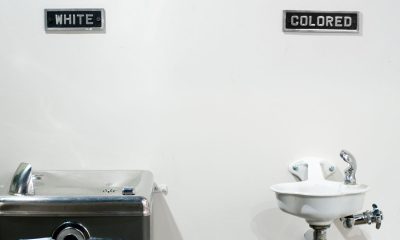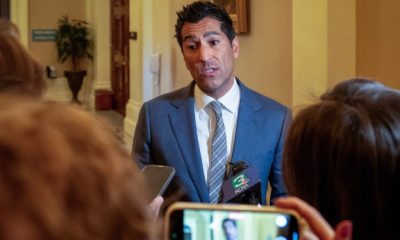Black Voice News
Vulnerable Seniors Remain at Risk, Waiting for State Legislators to Act
BLACK VOICE NEWS — On or about October 15, 2018, a patient with a chronic illness confined to the Legacy Post-Acute Rehabilitation facility in San Bernardino, was observed at about 8:30 am that morning with his/her feeding formula hung on a pole with tubing connected to the resident’s stomach through a feeding pump. The pump was beeping, and the screen indicated a “Hold Error,” i.e. the pump was set in the pause mode.

S.E. Williams | Contributor
On or about October 15, 2018, a patient with a chronic illness confined to the Legacy Post-Acute Rehabilitation facility in San Bernardino, was observed at about 8:30 am that morning with his/her feeding formula hung on a pole with tubing connected to the resident’s stomach through a feeding pump. The pump was beeping, and the screen indicated a “Hold Error,” i.e. the pump was set in the pause mode.
Around 8:55 a.m., a Licensed Vocational Nurse (LVN) entered the room briefly, ignored the beeping of the feeding pump and then sat just outside the door charting. At 9:00 a.m., a Respiratory Therapist entered the patient’s room to check the ventilator settings again the beeping was ignored. At 9:04 a.m., a Certified Nursing Assistant (CNA) entered and repositioned the patient in bed, again ignoring the feeding pump. At 9:33 a.m., a second LVN entered the room to assist the CNA with the patient’s care—both ignored the beeping. At 10:01 a.m., the Housekeeping Supervisor entered the room, checked the brake under the patient’s bed ignored the beeping and left; at 10:05 a.m., an Occupational Therapist entered the room to apply a boot—once again the beeping was ignored. It was not until 10:07 a.m., when a third LVN entered the room, was there any attention paid to the patient’s feeding pump and the fact that it was paused and beeping.
For more than an hour, six professionals entered and walked out of this patient’s room while the patient’s feeding tube beeped—a patient with a condition that required he/she be continuously fed with formula via a tube directly into his/her stomach—yet, the feeding tube flow was in a hold status and the pump continued beeping throughout this period. Sadly, not a single employee who entered the room took any action to investigate, report or restart the pump.
Only after a seventh individual (a third LVN), was asked by the inspector what the screen from the pump indicated and how long the feeding pump was beeping, did she confirm that the machine was—beeping. “The screen indicated ‘Hold Error,’” she promptly responded adding, “I am not sure how long the feeding pump was beeping and on hold—but,” she admitted, “the feeding was supposed to be continuous.”
When the Director of Nursing at the facility was later asked by the investigator what her expectation was for licensed and unlicensed staff when they hear the feeding pump beeping, she replied, “Licensed nurses should check the pump prior to resuming it when the feeding pump is beeping…the unlicensed nurses cannot resume the feeding pump when it is beeping, but they should report it to the LVNs.”
In another example, on or about September 29, 2018 an investigator made an unannounced visit to the Rialto Post Acute Center in Rialto. During the review of a resident’s file the investigator learned of an incident where the patient was found outside the facility.
After reviewing the file, the investigator dug further and learned the resident in question at some point was evaluated for his/her “Risk of Elopement” (unsupervised wandering) and was rated an 8 out of 10, with 10 posing the greatest risk. Within about four days of that assessment, a family member arrived at the Rialto Post Acute Center around 4:14 p.m. to visit and saw the resident outside by a bus stop located in front of the facility.
When confronted, he was described as both “agitated and physically aggressive.” For his safety, the resident was brought back to the facility.” While bringing patient/resident back into the facility, he attempted to bite staff, “He grabbed my shirt, scratch my arm with his nails—when we got back to the facility, he hitting me on my side,” a staff member reported.
Many question what might have happened to the patient if his family member had not happened by and found the resident on the street? According to the report, “This failure had the potential to result in the incident not being investigated, causing adverse reactions, affecting the overall health and safety of the resident…”
The inspector determined that the facility had no documented evidence it ever reported the incident to the California Department of Public Health as required.
These are only two examples of the dozens and dozens of care facility infractions identified through investigations by the California Department of Public Health through its state enforcement actions that often find patients at risk—at times leveling fines—at care facilities locally and up and down the state.
Last May when the state auditor published findings in its report, “Skilled Nursing Facilities: Absent Effective State Oversight, Substandard Quality of Care,” about the quality of care, financial practices, and statewide oversight of California’s skilled nursing facilities concluded, “The state had failed to adequately address ongoing deficiencies related to the quality of care that nursing facilities provide.”
The report found between the years 2006 and 2015, the number of substandard care deficiencies documented at nursing facilities, increased by a stunning and sobering “31” percent.
In addition, the report looked at the role of three companies up and down the state, Brius, Plum, and Longwood, who have increased their net incomes by tens of millions of dollars over the previous decades. “The net income of all three companies grew from less than $10 million in 2006 to between $35 million and $54 million by 2015.”
These companies also earned additional income (collectively well over $330 million) from the government by what some call “double-dipping.” For example, either they or their family members owned many of the vendors from which many of the products, supplies, etc. needed to operate their care facilities were purchased.
Related‑party transactions according to the auditor’s office are common in the industry and legally allowable. Although Medi‑Cal purportedly works to limit the possibility that it might pay for profits from related‑party transactions, it appears it has fallen short as the audit found these companies paid between $37.2 million and $65.7 million to related parties between 2007 through 2015. In most instances, auditors found the companies properly disclosed the related‑party transactions as required.
Among other factors uncovered by state auditors was the Department of Health Care Services’ eligibility system for Medi‑Cal which auditors found had paid billions in questionable Medi‑Cal premiums and claims because it failed to follow up on eligibility discrepancies between the state’s eligibility system and the counties’ eligibility systems.
Auditors recommended the department resolve the discrepancies and recover erroneous payments where allowable. Auditors further noted the department could avoid paying $1.7 billion per year if it resolved the discrepancies.
In February, the California State Auditor presented a special report summarizing audit investigation reports produced by the agency between January 2017 and December 2018 with the goal of assisting the Assembly Budget Committee in identifying issues it may want to explore in subcommittee hearings.
“It is intended to provide transparency in what actions, if any, audited and investigated entities have taken in response to our specific findings and recommendations,” California Auditor Elaine Howle stated.
Several recommendations were made to the state Assembly Subcommittee on Health and Human Services on issues ranging from the Mental Health Services Act funding to what Howle called, “questionable Medi‑Cal payments made by the Department of Health Care Services.”
In her communication to the members of the Assembly Budget Committee she stated, “Our audit efforts bring the greatest return when entities act upon our findings and recommendations.” She further shared how, “. . . the state’s budget process is a good opportunity for the Legislature to explore these issues in a public forum and, to the extent necessary, reinforce the need for corrective action.”
During the initial report period while the number of substandard care deficiencies received at care facilities in California increased by 31 percent, at the same time, the number of state citations from the Department of Public Health decreased by 34 percent—auditors found the Department of Public Health responded slowly to potential patient care violations.
Auditors also found deficiencies associated with noncompliance that caused or were likely to cause serious injury, harm, impairment, or death to residents increased by 35 percent between 2006 and 2015; that the Department of Public Health (DPH) had not fulfilled many of its oversight responsibilities meant to ensure that nursing facilities meet quality-of-care standards; that licensing decisions appeared inconsistent due to DPH’s poorly defined review processes and failures to adequately document rationale for approving or denying license applications.
In addition, auditors determined DPH had not performed all the state inspections of nursing facilities required. The agency also failed to issue citations in a timely manner, among other determinations.
In its initial report the auditor made several recommendations that ranged from calling on the Department of Health Care Service to revise and update the peer groups it uses to set Medi-Cal rates and in doing so to take into consideration the consolidation of the nursing facility industry; to calling on the legislature to reconsider current efforts to improve the quality of care through an existing financial incentive program determined to not be as effective as it could be because as noted, “the program’s budget is limited and only a small number of facilities receive the incentives.”
The audit team recommended the state consider repurposing over $330 million in quality assurance fees to increase both the amount available for such incentives and the impact that financial incentives can have on quality of care.
It also recommended the state modify its nursing facility quality assurance fee by requiring nursing facilities to demonstrate quality-of-care improvements in order to receive reimbursements of all or some portion of their quality assurance fee payments. The purpose of this fee is to enhance federal financial participation in the Medi-Cal program, and to provide additional reimbursement and support for quality improvement efforts in licensed facilities that provide services for the Medi-Cal program.
If nursing facilities do not show improvements, auditors recommended Health Care Services should redistribute their quality assurance fee payments to those nursing facilities that have improved. In an effort further aimed at improving the quality of patient care, the auditor recommended the department increase citation penalty amounts each year by—at minimum—the cost of inflation.
In total, the audit team made 12 recommendations to the legislature and state departments on this issue. To date, the legislature has only enacted legislation on one issue, five are pending and to date the legislature has failed to act on half of them.
Every day in the Inland Empire and across the state tens of thousands of elderly and disabled Californians rely on skilled nursing facilities to provide them 24 hour inpatient care yet the system appears fraught with patient risks, operational irregularities and waste.
In California the oversight responsibilities for nursing facilities are spread across three state agencies. They include the California Department of Public Health (CDPH), the Department of Health Care Services, and the Office of Statewide Health Planning and Development.
Auditors determined DPH had not fulfilled many of the oversight responsibilities meant to ensure nursing facilities meet quality of care standards. They further determined because all three state agencies failed to adequately coordinate their oversight efforts—it produced inefficiencies.
In her February letter to the Assembly Budget Committee about this and other audited issues Howle expressed her team’s belief, “The State’s budget process is a good opportunity for the legislature to explore these issues in a public forum and, to the extent necessary, reinforce the need for corrective action.”
Those with family members and/or friends in these facilities and/or who care passionately about the care and treatment of seniors and the disabled expect the legislature to take appropriate action on this important issue as the number of California seniors is expected to explode in the coming years placing increased demands on a system already struggling to provide adequate care.
To view the 2018 report, Skilled Nursing Facilities: Absent Effective Oversight, Substandard Quality of Care Has Continued, visit https://www.bsa.ca.gov/pdfs/reports/2017-109.pdf. To view the February 2019 report, Implementation of State Auditor’s Recommendations: Special Report to Assembly Budget Subcommittees, visit https://www.auditor.ca.gov/pdfs/sr2019/2019-406a.pdf. To research the status of long-term care facilities including their compliance history visit http://hfcis.cdph.ca.gov/.
This article was originally posted to Voice news on March 28, 2019.
This article originally appeared in Black Voice News.









































